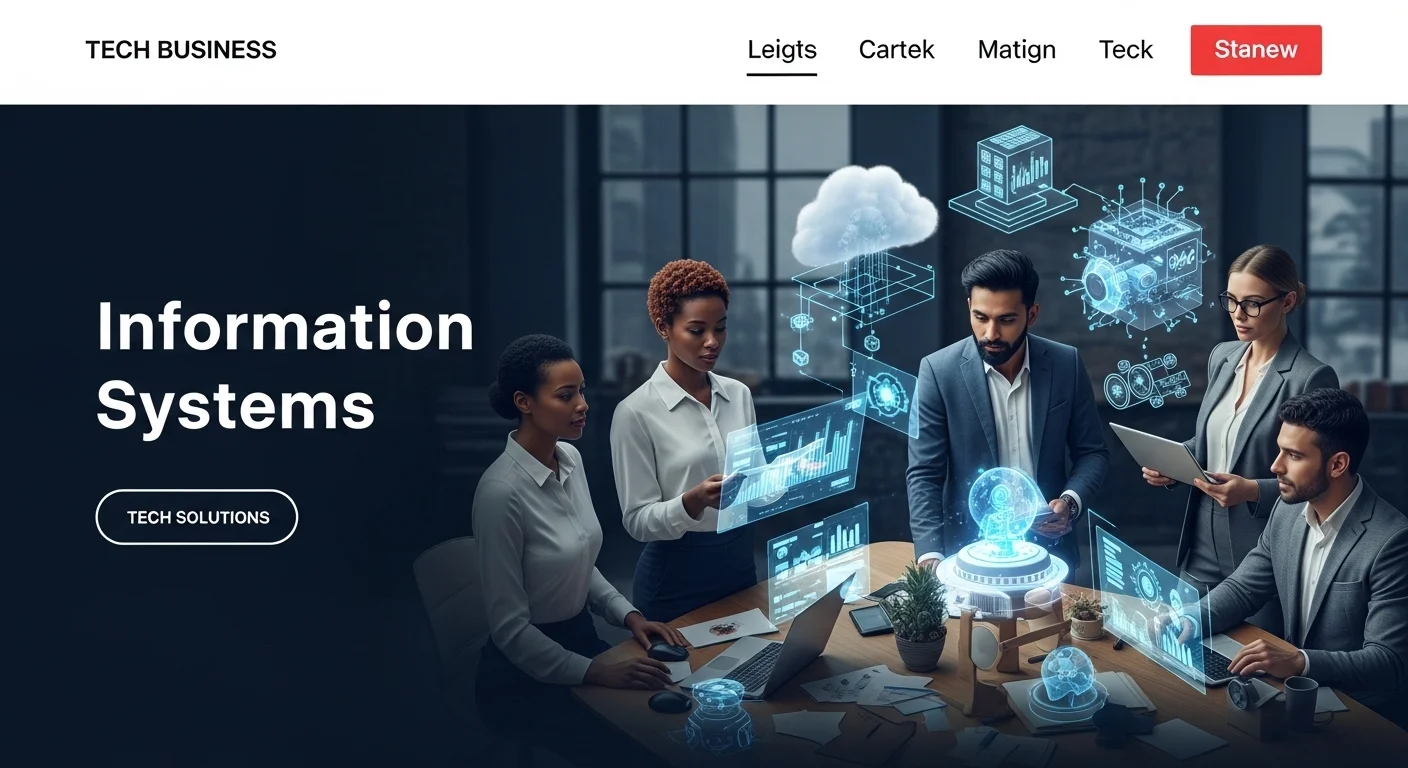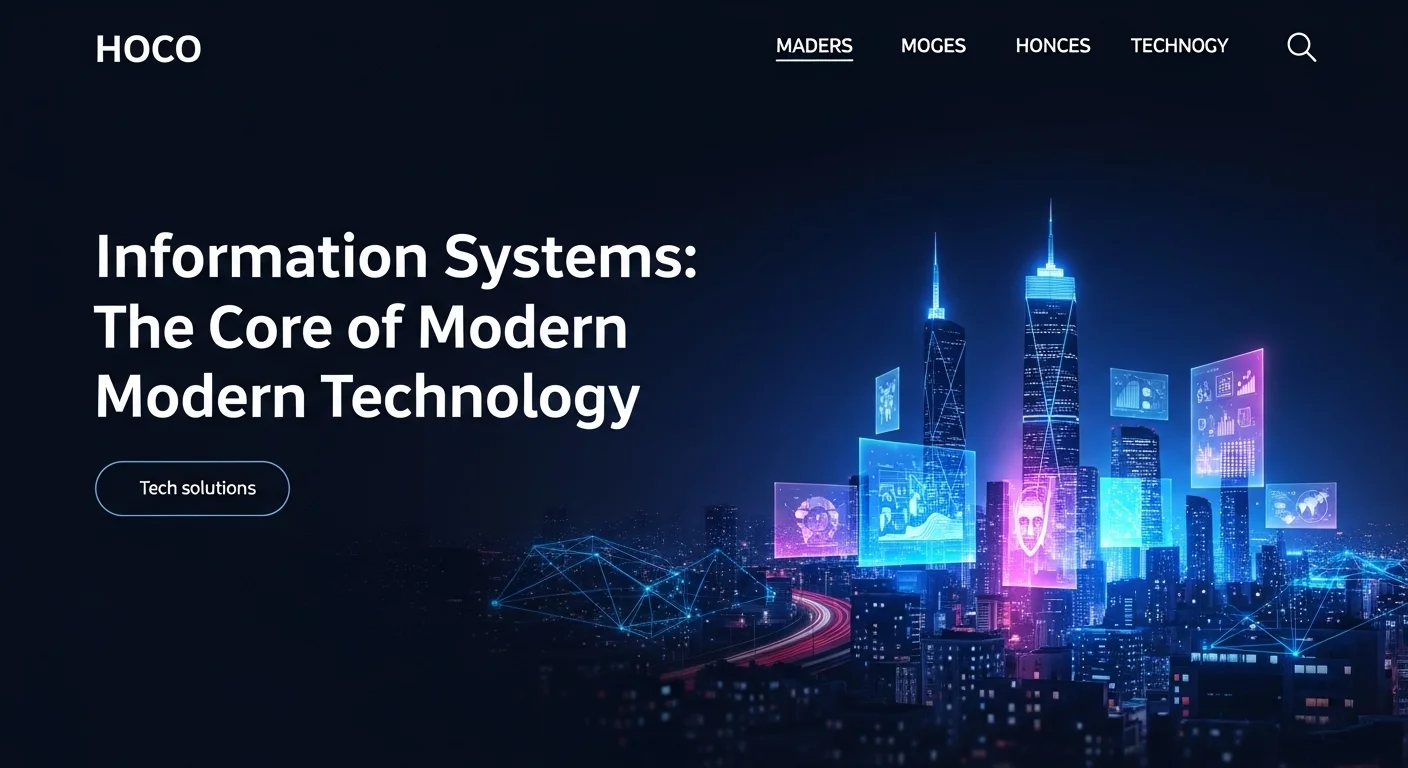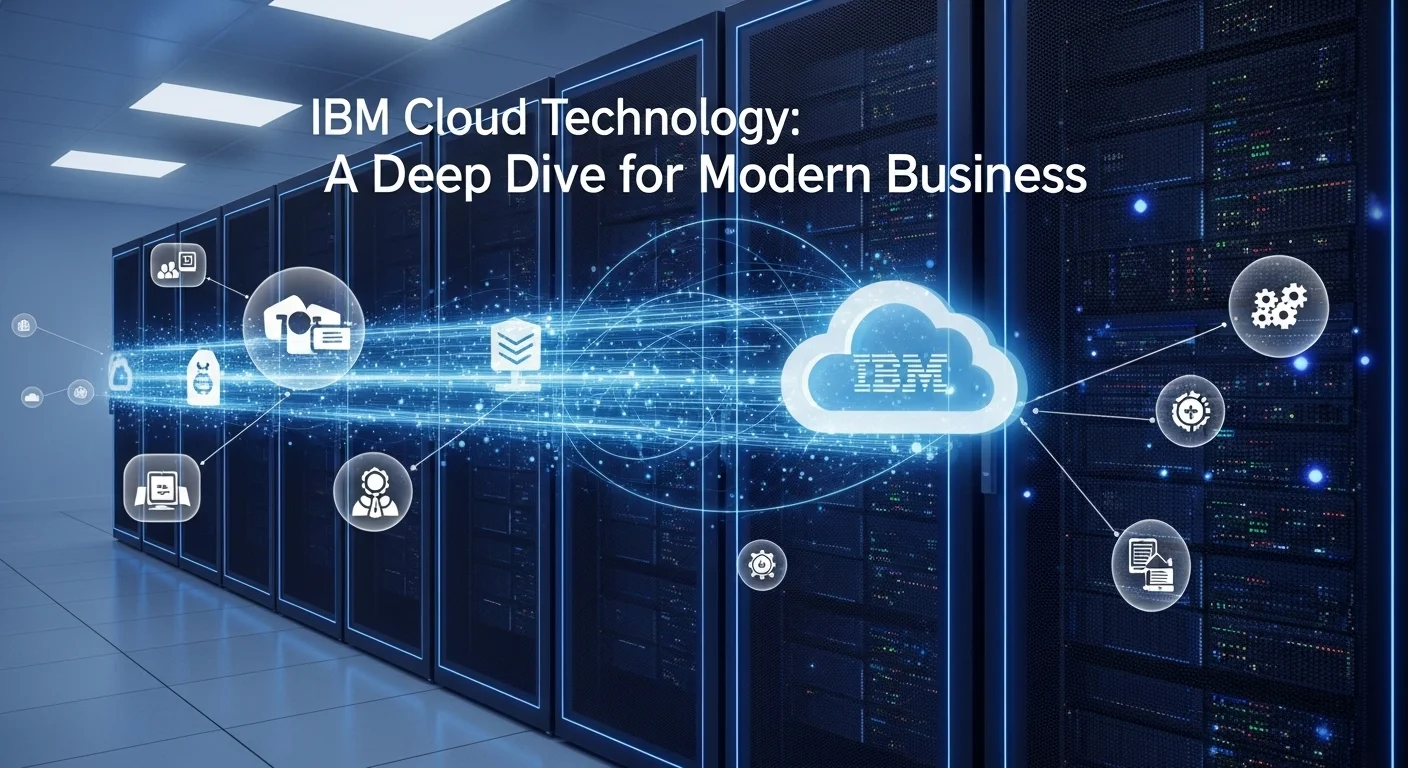What Are Information Systems? A Plain-English Guide for Your Business

Executive Summary
In my years as a technology consultant, I've seen countless businesses get tangled up in complex tech talk. But the concept at the heart of it all, Information Systems (IS), is actually straightforward. It’s not just about the computers or the software; it’s the complete recipe that blends technology, people, and processes to turn raw data into smart business decisions. Think of it as the central nervous system of your company. This guide is designed to cut through the noise. We'll explore what these systems are, the different types you might encounter—from managing sales data to streamlining a university's student records—and how you can leverage them. Whether you're a business leader, a student, or just curious about technology, understanding IS is the key to unlocking efficiency, innovation, and a real competitive edge. Let's demystify it together.
Table of Contents
Table of Contents
- What is an Information System, Really?
- The 5 Core Components of an Information System
- A Tour of Different Information Systems
- Why Information Systems Are Your Business's Secret Weapon
What is an Information System, Really? And Why It Matters.
In our connected world, you hear 'Information Systems' (IS) all the time, but what does it actually mean? Let's simplify. An information system is an organized combination of people, hardware, software, data, and processes, all working together to collect, manage, and share information. I’ve found the best way to explain it is to distinguish it from Information Technology (IT). Think of a car: IT is the engine, the wheels, and the electronics—the physical parts and the code that runs them. But an Information System is the *entire car*, plus the driver (the people), the rules of the road (the processes), the fuel (the data), and the destination (the business goal). The system is about the whole journey, not just the individual parts. Technology and Information Systems is the field focused on making sure this entire journey is smooth, efficient, and gets the organization exactly where it needs to go. This is why it’s so important; these systems are the engine of modern business, driving everything from simple daily sales to high-level strategic plans.
The goal isn't just to have the fanciest technology. It's about aligning that tech with how your business actually works to solve real problems for real people. When a company gets this right, the results are incredible. Processes become smoother, innovation blossoms, and it creates a genuine advantage in the market. A well-designed information system is what allows a company to manage its supply chain without a hitch, build lasting customer relationships, and handle its resources effectively. It’s the invisible framework that holds a successful modern business together.
The 5 Core Components of an Information System
To really get a feel for information systems, let's pop the hood and look at the five essential parts that work in harmony. Understanding these building blocks helps you see how raw facts are transformed into something truly useful.
- Hardware: This is all the physical stuff you can touch. I'm talking about computers, servers, smartphones, printers, and network cables. It’s the tangible foundation of the system, providing the muscle for processing and storage.
- Software: If hardware is the body, software is the brain. It's the set of instructions that tells the hardware what to do. This includes the operating system (like Windows or iOS) that manages the machine, and the application software (like your accounting program or a customer database) that performs specific tasks for you. For computer information systems, software is the intelligence that makes everything work.
- Data: Data is the raw material—the numbers, text, and images you collect. On its own, a list of numbers might not mean much. But when the system processes and organizes it, that data becomes valuable information. Think of databases as the libraries that expertly store and organize all this data so it can be found and used easily.
- People: Honestly, I believe people are the most critical component. They are the ones using, managing, and maintaining the system. From the person entering customer orders to the CEO looking at a dashboard to make a multi-million dollar decision, the system is useless without people. Their skills and willingness to use the system properly are what truly determine its success.
- Processes: These are the rules of the game. Processes are the steps and procedures that dictate how everything works together. They define how data is captured, what calculations are made, and who gets to see the final information. Well-thought-out processes ensure the system runs consistently, accurately, and efficiently.
A Tour of Different Information Systems
Organizations aren't one-size-fits-all, and neither are their information systems. Different systems are built for different jobs and for different levels of an organization. I like to picture it as a pyramid. At the bottom, you have systems handling the daily grind. As you move up, the systems get more sophisticated, helping managers and executives see the bigger picture. A classic example that sits in the middle is the management information system (MIS), which gives managers the reports they need to steer their teams. A more specialized tool is a student information system (SIS), which is the backbone of any modern school or university. Let's look at the most common types:
- Transaction Processing Systems (TPS): These are the workhorses. They live at the operational level and record all the routine, daily activities like sales, payroll, and shipping. A TPS is all about speed and accuracy, making sure the fundamental business transactions are captured perfectly every time.
- Management Information Systems (MIS): As I mentioned, an MIS serves middle management. It takes all the raw data from the TPS and turns it into summary reports (e.g., 'weekly sales by product line'). These reports help managers track progress, keep operations under control, and make well-informed, routine decisions.
- Decision Support Systems (DSS): A DSS is the next level up, designed for senior managers facing more complex problems where the answer isn't always clear. It's an interactive tool that allows them to play with data, ask 'what-if' questions (like 'What if we increase our marketing budget by 15%?'), and model different scenarios to see potential outcomes before making a call.
- Executive Information Systems (EIS): Sitting at the very top of the pyramid, an EIS is built for top-level executives. It provides a high-level, bird's-eye view of the entire organization, often through a clean graphical dashboard. It filters out the noise and presents the most critical data to help executives with long-term strategic planning.
- Office Automation Systems (OAS): These are the tools that boost everyday productivity. Think word processors, email, and collaboration platforms like Slack or Microsoft Teams. They help information flow smoothly and keep everyone connected.
- Knowledge Work Systems (KWS): These systems are designed for people whose job is to think—engineers, scientists, and architects. A KWS provides powerful tools like computer-aided design (CAD) software or complex data modeling applications to help them create and integrate new knowledge into the business.
Why Information Systems Are Your Business's Secret Weapon
In today's market, thinking of information systems as just a necessary cost is a huge mistake. They are a powerful strategic asset that can completely transform a business. When I work with clients, we focus on three key benefits: boosting efficiency, making smarter decisions, and building stronger customer connections. By automating repetitive tasks with computer information systems, you can slash costs and free up your team to focus on work that truly creates value. For example, a system called an Enterprise Resource Planning (ERP) system can act as the central hub for an entire business, connecting everything from manufacturing and sales to finance and HR on a single platform. This gives a unified view that was impossible before.
Moreover, a solid management information system gives leaders the clear, timely information they need to navigate a fast-moving market. The ability to spot a trend and react quickly is what separates the winners from the losers. Take the student information system at a university. It does far more than just store grades. It provides administrators with the data to see enrollment patterns, identify struggling students who need help, and allocate campus resources wisely. This data-driven approach directly improves the student experience and helps the university thrive. Ultimately, weaving together these different types of information systems makes a company more agile and innovative. The synergy between your business goals and your technology strategy is no longer optional—it's the core competency of any modern market leader.

The Complete Playbook for Information Systems in Business
As we move from the 'what' to the 'how,' it’s time to look at the complete playbook for using Technology and Information Systems. For me, this always starts with understanding the system's lifecycle. Think of it as the journey of bringing a new technology solution to life, from a simple idea to a fully functioning tool. In the industry, we call this the Systems Development Life Cycle (SDLC), but you can just think of it as a proven roadmap for planning, building, and launching a system. The goal is always the same: to create a high-quality system that actually solves the intended problem, stays on budget, and works seamlessly for the people who use it. Mastering this lifecycle is crucial for anyone in the computer information systems field because it provides the structure needed to turn a business need into a real-world solution.
This journey has a few key phases. The first, Planning, is where the magic really begins. It’s where you define the problem you’re trying to solve and figure out if a new system is technically, economically, and organizationally feasible. It’s all about ensuring the project aligns with the company's big-picture goals. Next comes Analysis, where the team sits down with the future users to map out every single requirement. This is where you listen more than you talk. Then, in the Design phase, you create the blueprint for the system—what it will look like, how the database will be structured, and how it will be secured. The Implementation phase is where developers write the code and build the system, followed by intense Testing to hunt down and squash any bugs. Finally, the system goes live, and the Maintenance phase begins. This final phase is a long-term commitment to support, update, and improve the system over time. Each step is a vital part of building powerful and lasting information systems.
The Tech and Business Moves That Make a System Succeed
I've learned that a successful information system is born from a perfect marriage of smart technology and sharp business thinking. On the tech side, managing data is everything. For decades, the gold standard has been relational databases using SQL, which are fantastic for structured data like financial records. But now, with the explosion of 'Big Data' from social media and other sources, we have tools like NoSQL databases. I explain it to clients like this: SQL is like a perfectly organized filing cabinet, great for specific information. NoSQL is like a giant storage bin, perfect for quickly dumping and retrieving massive amounts of varied information. Another game-changer is cloud computing. Instead of buying and maintaining a room full of expensive servers, you can effectively 'rent' computing power from services like Amazon Web Services or Microsoft Azure. This has made powerful technology accessible to businesses of all sizes.
On the business side, how you manage the project is just as important. I’m a huge fan of Agile methodologies. Instead of trying to build the entire system in one long go, Agile breaks the project into small, two-week 'sprints.' At the end of each sprint, you have a small, working piece of the product to show users and get their feedback. It’s like building a car piece by piece and letting the driver test it along the way, ensuring the final product is exactly what they want. Another powerful business technique is fundamentally rethinking how you work, often called Business Process Reengineering (BPR). Implementing a new system is the perfect trigger for BPR, as it forces you to question old, inefficient habits. This fusion of technical skill and business strategy is what ensures all types of information systems, from a targeted management information system to a massive ERP, deliver real value.
A Closer Look: Management Information Systems (MIS)
A management information system (MIS) is a manager's best friend. I've helped implement dozens of them, and their purpose is always clear: to empower middle managers to make better, faster decisions. An MIS takes the flood of raw data from daily operations (captured by a TPS) and distills it into clear, concise summary reports. These are the systems that tell a sales manager which products are flying off the shelves and which are collecting dust, or tell a factory supervisor about production efficiency day by day. The reports are usually structured and delivered on a regular schedule, which allows managers to track performance over time and against their goals.
Imagine you're a retail manager. Your MIS might give you a report every Monday morning showing last week's sales figures broken down by store, region, and item category. If you see that one region is suddenly lagging, that report is your cue to investigate. It provides the 'what' so you can dig into the 'why.' While older MIS were fairly rigid, modern management information systems are much more dynamic. They often include interactive dashboards and some analytical tools, bridging the gap between simple reporting and deeper business intelligence. Within the broad family of computer information systems, the MIS is the critical link that connects the frontline action to the company's overall strategy, ensuring managers have the visibility they need to lead effectively.
Case Study: The Student Information System (SIS)
If you want a perfect, real-world example of a specialized information system, look no further than a student information system (SIS). I find them fascinating because they touch every part of an educational institution. An SIS is a comprehensive platform that manages the entire student journey, from the first application form to the final graduation ceremony. It is the single source of truth for students, faculty, administrators, and even parents. It perfectly illustrates the five components of information systems in action: the servers (hardware), the SIS application (software), millions of student records (data), the thousands of users (people), and the complex processes of admissions, registration, and grading (processes).
A modern SIS is built from different modules that handle specific jobs:
- Admissions: Manages online applications and tracks prospective students.
- Registration: The system students use to sign up for classes each semester.
- Grades and Transcripts: Where professors enter grades and official academic records are stored.
- Billing and Financial Aid: Manages tuition, fees, scholarships, and payments.
- Student Portal: The online hub where a student can check their grades, view their schedule, and handle their administrative tasks.

Practical Tips and Strategies to Elevate Your Technology Experience
So, you're ready to make your technology work better for you? Fantastic. In my experience, harnessing the real power of Technology and Information Systems is less about buying flashy new gadgets and more about a smart, people-focused strategy. It all starts with choosing the right tools for the job. Before you even look at vendors, conduct a thorough analysis of your own needs. Get your team involved—the people who will use the system every day. They know the real-world pain points. I always advise clients to make two lists: 'must-have' features and 'nice-to-have' features. This clarity will be your compass when navigating sales pitches. Whether you're looking for a simple tool or a comprehensive management information system (MIS), this groundwork is essential.
Once you've chosen a system, the real work begins: implementation and getting your people on board. This is where so many projects stumble. You can have the best computer information system on the market, but if your team doesn't embrace it, it's a wasted investment. A robust training plan is non-negotiable, and it should be customized for different roles. But don't stop there. You need a change management strategy. You have to be the chief storyteller, explaining *why* this change is happening and how it will make everyone's job better—not just the company's bottom line. Highlight early successes and celebrate the small wins to build momentum. Focusing on the human side is the single most important factor in getting a real return on any of the types of information systems you implement.
My Best Practices for Managing Information Systems
Effective management isn't a one-time setup; it's a continuous commitment. Here are the best practices I've seen deliver results time and time again.
- Treat Your Data Like Gold: There's an old saying in tech: 'garbage in, garbage out.' Your system is only as good as the data inside it. Establish clear rules for data governance—who owns it, who can access it, and how you keep it clean and accurate. Run regular audits to weed out bad data. This is the foundation for reliable reports from your management information systems.
- Build a Digital Fortress with Cybersecurity: In today's world, securing your systems is not optional. Use a multi-layered defense: strong firewalls, up-to-date antivirus software, and strict access controls (give people access only to what they absolutely need). Most importantly, train your people. They are your first and last line of defense against phishing scams and other threats.
- Constantly Monitor and Tune Performance: Your systems are living things. Keep an eye on their performance. Are they running slow? Are they nearing storage limits? Monitoring key metrics helps you spot bottlenecks before they become major problems. A system needs regular tune-ups to keep running at peak performance.
- Align with Your Business and Plan for Growth: Your tech strategy and your business strategy must be in lockstep. Regularly ask, 'Is our technology still helping us achieve our goals?' And as you plan for business growth, make sure your systems can grow with you. Scalable solutions, especially cloud-based ones, are key to avoiding painful and expensive system replacements down the road.
- Have a 'Plan B' for Disasters: What if the worst happens—a fire, a flood, a major cyberattack? A Disaster Recovery Plan is your insurance policy. This means having regular, automated backups of your data stored in a separate, secure location and a clear plan to get your systems back online quickly. For a system like a student information system, which holds critical records, this is non-negotiable.
Essential Business Tools and My Tech Experience
The modern toolkit for computer information systems is incredibly powerful, especially with so many great cloud-based options available. Here are a few categories I see as essential:
- Customer Relationship Management (CRM) Systems: Tools like Salesforce or HubSpot are like a digital Rolodex on steroids. They are the central hub for every customer interaction, from the first marketing email to the final sale and ongoing support. They are a game-changer for understanding and serving your customers.
- Enterprise Resource Planning (ERP) Systems: ERPs from providers like SAP or Oracle NetSuite are the big guns. They aim to be the single source of truth for an entire organization, connecting finance, HR, manufacturing, and the supply chain. They are a massive undertaking but can bring incredible efficiency to larger businesses.
- Collaboration Platforms: Tools like Slack and Microsoft Teams have become the digital office for many companies. They are vital for real-time communication, file sharing, and project management, especially in a world with remote and hybrid teams.
- Business Intelligence (BI) and Analytics Tools: Platforms like Tableau and Microsoft Power BI are where your data comes to life. They connect to all your other systems and let you create visual, interactive dashboards. This is how you move from just collecting data to actually using it to find trends and make smart, data-driven decisions.
To keep a pulse on what's next, I always recommend leaders stay curious and explore resources from forward-thinking publications like WIRED. The tech experience today is all about intelligent integration—making sure your CRM can talk to your e-commerce platform, which can then feed data into your BI tool. It's about building a seamless digital ecosystem where data flows freely, empowering your team and creating better experiences for your customers. That is the ultimate goal of a truly strategic approach to Technology and Information Systems.
Expert Reviews & Testimonials
Sarah Johnson, Business Owner ⭐⭐⭐
This was a great overview of Information Systems. As a small business owner, I would have loved to see a case study on how a company like mine, with a tight budget, could implement a simple CRM or inventory system.
Mike Chen, IT Consultant ⭐⭐⭐⭐
A solid, comprehensive article on IS. It's a great resource for IT professionals who need to explain these concepts to non-technical stakeholders. A few of the diagrams could be simplified, but overall, it’s very well done.
Emma Davis, Tech Expert ⭐⭐⭐⭐⭐
Fantastic article! I'm specializing in business analytics, and this piece perfectly connected the dots between theoretical IS models and real-world business applications. The section on MIS vs. DSS was especially clear. Highly recommended!



